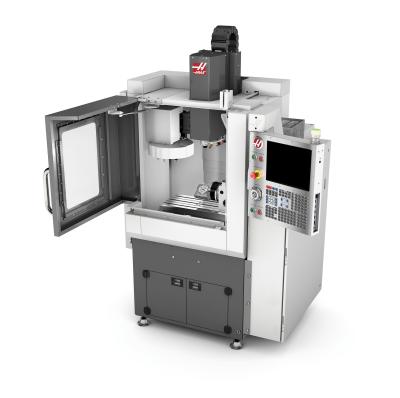
Small parts manufacturing can pose significant machining challenges for the average job shop. Tiny holes, minute features, extreme accuracies and fine surface finishes may prove difficult for larger CNC machines. Haas Automation’s new CM-1 compact mill is a small-footprint, high-accuracy solution for the production and prototyping of small, high-precision 2D and 3D parts, such as those found in the communications, aerospace, medical and dental industries.
The CM-1 features 12" x 10" x 12" travels, a 20" x 10" T-slot table, a 30,000-rpm ISO 20-taper spindle, and a 20-pocket automatic tool changer. Maximum cutting feeds are 500 ipm, with rapids to 757 ipm for reduced cycle times. The user-friendly NextGen Haas control makes set up and operation simple. Standard equipment includes a 15" color LCD monitor, 1 GB of program memory, Ethernet connectivity, a power-failure detection module, a USB port, a coolant system, high-speed machining software, and more. A number of high-productivity options are also available, including a 50,000-rpm spindle and full 5-axis capability.
The CM-1 is small enough to fit into most freight elevators, and can easily be moved with a pallet jack or equipment dolly. The machine runs on single-phase power.
For full 5-axis machining on the CL-1, Haas offers the TRT70, an ultracompact dual-axis tilting rotary table that provides ±120 degrees of tilt and 360 degrees of rotation to position parts to almost any angle for machining. The TRT70 provides 60 ft-lb (81.3 Nm) of torque on the tilt axis and 40 ft-lb (54.2 Nm) on the rotary axis for aggressive machining; and indexing speeds of 410 deg/sec on the tilt axis and 620 deg/sec on the rotary axis ensure short cycle times. The precision-ground 70 mm (2.76") platter features multiple bolt patterns and a precision through-bore for versatile fixturing, and will swing parts up to 4.0" (102 mm) diameter.
Contact Details
Related Glossary Terms
- computer numerical control ( CNC)
computer numerical control ( CNC)
Microprocessor-based controller dedicated to a machine tool that permits the creation or modification of parts. Programmed numerical control activates the machine’s servos and spindle drives and controls the various machining operations. See DNC, direct numerical control; NC, numerical control.
- coolant
coolant
Fluid that reduces temperature buildup at the tool/workpiece interface during machining. Normally takes the form of a liquid such as soluble or chemical mixtures (semisynthetic, synthetic) but can be pressurized air or other gas. Because of water’s ability to absorb great quantities of heat, it is widely used as a coolant and vehicle for various cutting compounds, with the water-to-compound ratio varying with the machining task. See cutting fluid; semisynthetic cutting fluid; soluble-oil cutting fluid; synthetic cutting fluid.
- inches per minute ( ipm)
inches per minute ( ipm)
Value that refers to how far the workpiece or cutter advances linearly in 1 minute, defined as: ipm = ipt 5 number of effective teeth 5 rpm. Also known as the table feed or machine feed.
- milling machine ( mill)
milling machine ( mill)
Runs endmills and arbor-mounted milling cutters. Features include a head with a spindle that drives the cutters; a column, knee and table that provide motion in the three Cartesian axes; and a base that supports the components and houses the cutting-fluid pump and reservoir. The work is mounted on the table and fed into the rotating cutter or endmill to accomplish the milling steps; vertical milling machines also feed endmills into the work by means of a spindle-mounted quill. Models range from small manual machines to big bed-type and duplex mills. All take one of three basic forms: vertical, horizontal or convertible horizontal/vertical. Vertical machines may be knee-type (the table is mounted on a knee that can be elevated) or bed-type (the table is securely supported and only moves horizontally). In general, horizontal machines are bigger and more powerful, while vertical machines are lighter but more versatile and easier to set up and operate.
